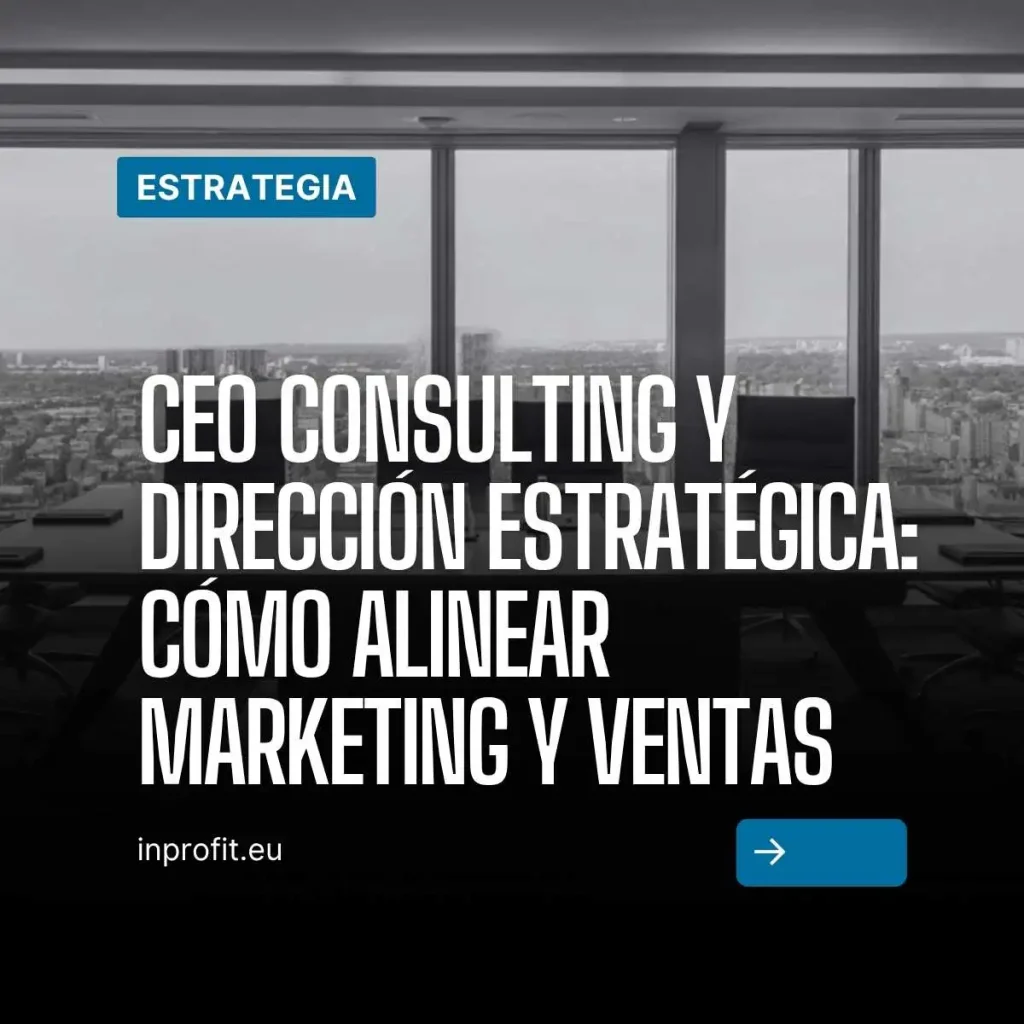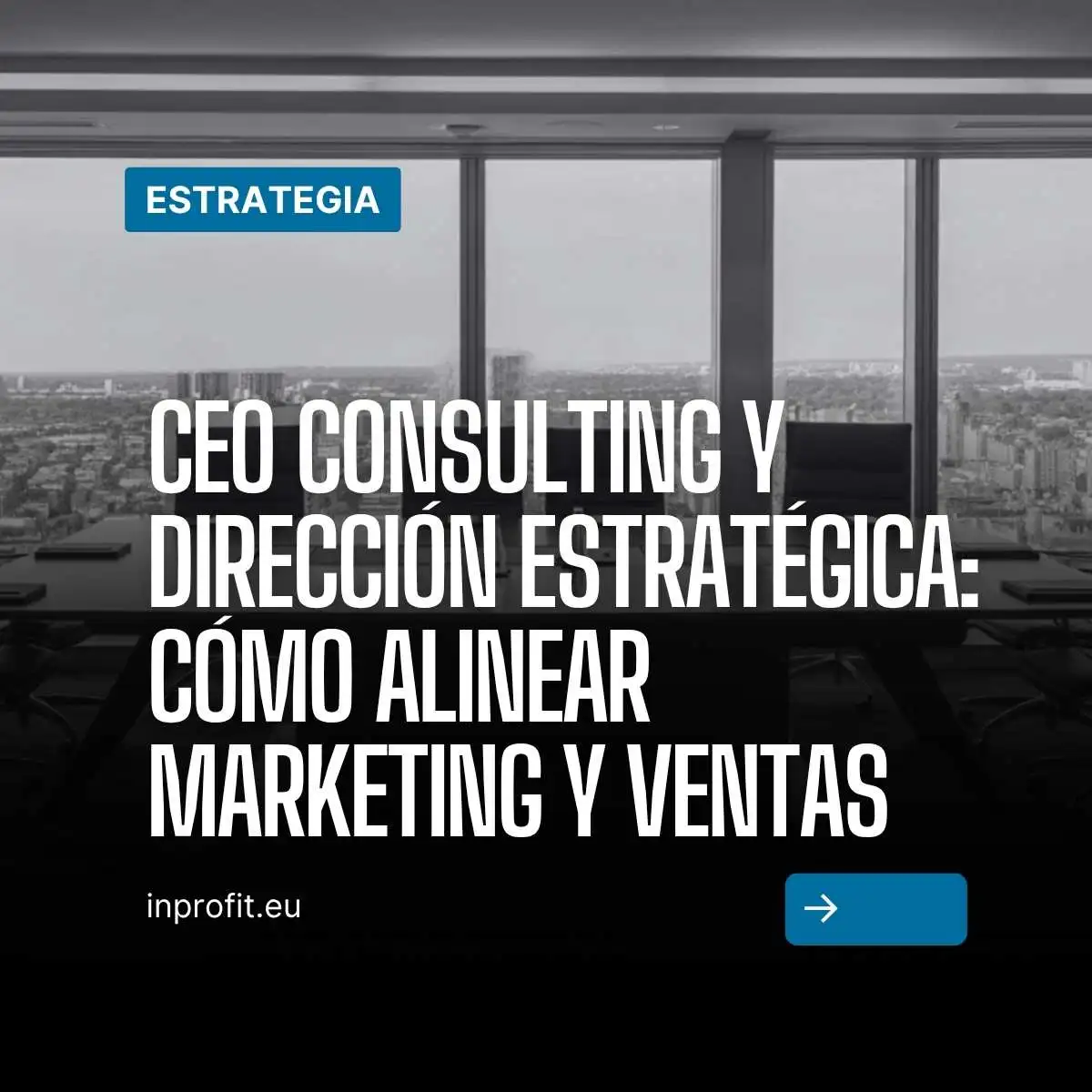When a company stagnates, the symptom often appears in the P&L: sales that don’t take off, tight margins and a mix of tactical actions that lack cohesion.
The antidote is not to “do more campaigns,” but to raise your sights. This is where CEO consulting brings value: helping the chief executive make structural decisions that connect the strategic direction of marketing and sales to sustainable growth.
What exactly is CEO consulting applied to marketing and sales?
CEO consulting is a high-level accompaniment to define (and execute) critical decisions: value proposition, offer architecture, go-to-market strategy, organizational design and performance metrics. It does not replace marketing or commercial management; it gives them focus, method and speed from the CEO’s chair.
Impact is measured in clarity (vision and positioning), coherence (priorities and trade-offs) and cadence (pace of execution). In other words: build a system that converts strategy into business results, without back-and-forth.
The strategic direction your go-to-market needs
The marketing and sales strategy is not a document; it is an operating system. Its pillars:
- Segmentation and focus: choose customer categories with margin potential, not just volume.
- Value proposition and narrative: what you promise and why you are the obvious choice (category entry points).
- Capture and conversion model: channels, content, SDR/BDR, sales cycle and playbooks.
- Pricing & packaging: how you charge and how you reduce buying friction.
- RevOps Orchestration: data, processes and technology to make marketing, sales and customer success work as one machine.
Would you like to audit your go-to-market in 10 days and detect quick wins? At Inprofit we can help you prioritize with data.
Signs that you need CEO consulting
- You grow in leads but the pipeline does not advance or falls into “no decision”.
- You rely too much on one or two paid channels and the CAC goes up quarter by quarter.
- The value proposition varies depending on who is telling it; there is no consistent narrative.
- Marketing reports “MQLs” and sales talks about “opportunities”, but no one shares an SLA.
- The forecast is optimistic… until the last week of the month.
From intention to execution: the 4D framework
One practical way to bring strategic direction down to earth is the 4D framework:
1) Diagnosis
Objective radiography in four layers: market (trends, competitors, alternatives), customer (jobs to be done, triggers, objections), product/service (differential value, testing), and commercial machine (funnel, conversions, productivity per rep, cycle and win rate). The questions that move the needle are defined here: which segment provides the best LTV/CAC, at which stage is the most value lost, which onboarding frictions slow down adoption?
2) Address
Strategic decisions: where to compete (priority segments), how to win (differentiation and evidence), with which levers (channels, partnerships, product-led or sales-led), and at what pace (milestones and resources). It translates into quarterly OKRs and a GTM roadmap.
3) Design
Organizational and operational design: roles, growth pod (marketing + sales + CS + analytics), MQL→SQL handover processes, playbooks by vertical, demo experience, economic proposition, and value-oriented pricing. RevOps weaves technology (CRM, marketing automation, data layer) to measure and optimize.
4) Deployment
Execution with cadence: weekly rituals (pipeline review, forecast, retro campaigns), experimentation sprints (messages, offers, sequences), continuous enablement and roadmap governance. Each sprint must leave a measurable improvement of the funnel.
Key questions a CEO should ask himself
Are we prioritizing the right segment?
If your best margin comes from medium-sized customers with implementation urgency, targeting content, use cases and discourse to that segment can double the win rate with the same team.
Is our narrative memorable in 7 seconds?
Most websites talk about themselves. Strategic direction demands a sticky value proposition: concrete problem, promised result, proof and “why now”. If you don’t get it, you don’t sell.
Do we measure what matters?
Activity reports are not enough. An executive dashboard should show: pipeline coverage, sales cycle by segment, win rate by reason, LTV/CAC, retention and expansion. Without this, you are sailing blind.
Marketing and sales: from silos to systems
To switch from friction to flow, four gears should be aligned:
- Common definition of lead and opportunity. An MQL without real intent is noise.
- Bidirectional SLA. Marketing is committed to quality; sales, to response time and feedback.
- Enabling content. Pieces designed for each stage and objection: comparatives, ROI, use cases.
- Closing the loop. The reasons for loss are transformed into new marketing and product experiments.
Is your funnel “leaking”? We show you where it is leaking.
Pricing and packaging: the forgotten accelerator
Price communicates value. Adjusting pricing & packaging usually has more impact than launching another channel. Some levers:
- Value anchors: prices that relate to the outcome (savings, income, risk avoided).
- Smart Bundles: combinations that solve a use case, not a list of features.
- Scalability: the client can start small and grow without re-negotiating everything.
Metrics governing strategic direction
- Pipeline coverage (≥3x monthly target per prioritized segment).
- Win rate per vertical and per reason.
- CAC payback and LTV/CAC (sustainability).
- Net retention and expansion (quality of value delivered).
- Productivity per representative (revenue/rep/month) and time-to-ramp.
The key is for each metric to respond to a decision: if the sales cycle goes up, what will we do differently this week?
Application cases: three common scenarios
a) Companies that depend on performance ads
Cost goes up, margin goes down. The answer is not “more budget,” but category storytelling, powerful social proof, strategic SEO and a highly segmented outbound motion that unlocks qualified demand.
b) B2B with complex sales
The winner here is the one who reduces the perceived risk: value-driven demos, ROI calculator, low-risk pilots, champions enablement and mutual action plans.
c) Industrial SMEs or traditional B2B services
The challenge is to market expertise. Strategy: verticalize messages, create packaged offers (diagnosis + plan + implementation), empower the team with scripts and playbooks and activate well-designed referrals.
Why work with a partner like Inprofit?
With a partner like Inprofit we combine strategic vision with implementation: from the go-to-market audit to the implementation of RevOps, enabling content and commercial support. We talk business and marketing at the same CEO’s table.
Frequently Asked Questions (FAQ)
Does CEO consulting replace the marketing or sales director?
No. It aligns and accelerates. Helps the CEO prioritize, and gives marketing and sales a shared framework that reduces friction.
When will I see results?
Quick wins usually appear in 4-8 weeks (conversion improvements, offer clarity). System consolidation comes in 2-3 quarters.
Do I need new tools?
Sometimes yes, but the priority is process and focus. With the current CRM and clear analytics you can already gain traction.
Strategic consulting
Strategy is not a pretty document: it’s a chain of connected decisions that transform how you win and close business. If you want to take your strategic marketing and sales direction to an operational level – with focus, cadence and sustainable growth – let’s talk.
At Inprofit we provide the method and seniority for your team to execute with confidence.




